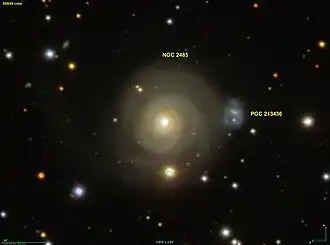NGC 2485
| NGC 2485 | |
|---|---|
 NGC 2485 taken by Sloan Digital Sky Survey | |
| Observation data (J2000 epoch) | |
| Constellation | Canis Minor |
| Right ascension | 07h 56m 48.66s |
| Declination | +07d 28m 40.62s |
| Redshift | 0.015391 |
| Heliocentric radial velocity | 4,630 km/s |
| Distance | 233 Mly (71.43 Mpc) |
| Apparent magnitude (V) | 12.2 |
| Apparent magnitude (B) | 13.1 |
| Surface brightness | 13.08 |
| Characteristics | |
| Type | Sa |
| Size | 110,000 ly |
| Apparent size (V) | 1.6' x 1.6' |
| Other designations | |
| PGC 22266, UGC 4112, IRAS 07541+0736, MCG+01-21-001, NSA 134732, SDSS J075648.66+072840.6, UZC J075648.7+0728400, LEDA 22266 | |
NGC 2485 is a spiral galaxy located in the constellation of Canis Minor.[1] It is located 233 million light-years away from Earth and has an estimated diameter of 110,000 light-years.[2] NGC 2485 was discovered on March 25, 1864, by Albert Marth[3] and has an approximate surface magnitude of 13.08.[4]
References
- ^ "NGC 2485 - Galaxy - SKY-MAP". server1.sky-map.org. Retrieved 2024-04-23.
- ^ "Your NED Search Results". ned.ipac.caltech.edu. Retrieved 2024-04-23.
- ^ "New General Catalog Objects: NGC 2450 - 2499". cseligman.com. Retrieved 2024-04-23.
- ^ "Data from NGC and IC catalogue by Wolfgang Steinickle from NGC 2400-2499". astrovalleyfield.ca. Retrieved 2024-04-23.